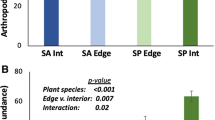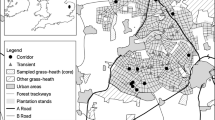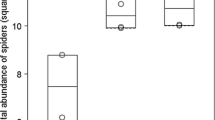Abstract
Increased edge effects in fragmented habitats can affect the abundance of edge-dwelling organisms, but these impacts may depend on the biological attributes of species. Microhabitat choice, a species characteristic that reflects combinations of biological traits, may affect the ability of peripheral species to take advantage of increased edge habitat in the presence of edge effects. In this field study, we built artificial shrub modules designed to encourage web spiders to build webs on the periphery. While modules were identical in volume, they differed in shape (cubic and elongated), so that elongated modules had more edge habitat and were subject to enhanced edge effects. Given that the tangle-web spiders Theridion and Dictyna built webs on module edges and strongly differed in terms of concealment and substrate generalization, two habitat characteristics associated with lower vulnerability to habitat modification, we tested the hypothesis that Theridion, which built webs in more concealed locations and on a greater diversity of substrate configurations in the modules compared to Dictyna, would take better advantage of increased edge habitat. As predicted, Theridion was significantly more abundant on elongated modules whereas the abundance of Dictyna did not respond to shape, even though the change in module shape entailed a similar increase in favored substrate for both spider groups. Our results suggest that the microhabitat associations of organisms may be linked to their propensity to be sensitive to edges, and that a better understanding of these links can improve our ability to predict the effects of habitat modification on biodiversity.




Similar content being viewed by others
References
Anderson L, Burgin S (2008) Patterns of bird predation on reptiles in small woodland remnant edges in peri-urban north-western Sydney, Australia. Landsc Ecol 23:1039–1047. doi:10.1007/s10980-008-9252-5
Andren H, Angelstam P (1988) Elevated predation rates as an edge effect in habitat islands: experimental evidence. Ecology 69:544–547
Atlegrim O (1989) Exclusion of birds from bilberry stands: impact on insect larval density and damage to the bilberry. Oecologia 79:136–139. doi:10.1007/BF00378251
Benjamin SP, Zschokke S (2002) Untangling the tangle-web: web construction behavior of the comb-footed spider Steatoda triangulosa and comments on phylogenetic implications (Araneae: Theridiidae). J Insect Behav 15:791–801. doi:10.1023/A:1021175507377
Blackledge TA, Coddington JA, Gillespie RG (2003) Are three-dimensional spider webs defensive adaptations? Ecol Lett 6:13–18. doi:10.1046/j.1461-0248.2003.00384.x
Brand LA (2004) Prediction and assessment of edge response and abundance for desert riparian birds in southeastern Arizona. PhD thesis. Colorado State University, Fort Collins, USA
Buchholz S (2010) Ground spider assemblages as indicators for habitat structure in inland sand ecosystems. Biodivers Conserv 19:2565–2595
Burkey TV (1993) Edge effects in seed and egg predation at two neotropical rainforest sites. Biol Conserv 66:139–143. doi:10.1016/0006-3207(93)90145-Q
Caley MJ, St John J (1996) Refuge availability structures assemblages of coral reef fishes. J Anim Ecol 65:414–428
Chamberlin RV, Gertsch WJ (1958) The spider family Dictynidae in America north of Mexico. B Am Mus Nat Hist 116:1–152
Chew RM (1961) Ecology of the spiders of a desert community. J NY Entomol Soc 69:5–41
Cloudsley-Thompson JL (1962) Microclimates and the distribution of terrestrial arthropods. Annu Rev Entomol 7:199–222
Cutler B, Jennings DT, Moody MJ (1977) Biology and habitats of the lynx spider Oxyopes scalaris Hentz (Araneae: Oxyopidae). Entomol News 88:87–97
Davies KF, Margules CR, Lawrence JF (2004) A synergistic effect puts rare, specialized species at greater risk of extinction. Ecology 85:265–271
Eggleston DB, Lipcius RN, Grover JJ (1997) Predator and shelter-size effects on coral reef fish and spiny lobster prey. Mar Ecol Prog Ser 149:43–59
Ehmann WJ (1994a) The organization of shrub-steppe spider assemblages: a hierarchical evaluation of deterministic and stochastic influences. PhD dissertation, Department of Biology, Utah State University, Logan, Utah, USA
Ehmann WJ (1994b) Spider habitat selection: an experimental field test of the role of substrate diameter. J Arachnol 22:77–81
Ehmann WJ (1994c) Organization of spider assemblages on shrubs: an assessment of the role of dispersal mode in colonization. Am Midl Nat 131:301–310
Ehmann WJ, MacMahon JA (1996) Initial tests for priority effects among spiders that co-occur on sagebrush shrubs. J Arachnol 24:173–185
Ewers RM, Didham RK (2006) Confounding factors in the detection of species responses to habitat fragmentation. Biol Rev 81:117–142
Ewers RM, Didham RK (2007) The effect of fragment shape and species’ sensitivity to habitat edges on animal population size. Conserv Biol 21:926–936
Fagan WF, Cantrell RS, Cosner C (1999) How habitat edges change species interactions. Am Nat 153:165–182
Ferguson SH (2000) Predator size and distance to edge: is bigger better? Can J Zool 78:713–720. doi:10.1139/cjz-78-5-713
Foelix RF (1996) Biology of spiders, 2nd edn. Oxford University Press, NY
Gilpin ME, Diamond JM (1976) Calculation of immigration and extinction curves from the species-area-distance relation. PNAS 73:4130–4134
Hackett HM, Pagels JF (2003) Nest site characteristics of the endangered northern flying squirrel (Glaucomys sabrinus coloratus) in Southwest Virginia. Am Midl Nat 150:321–331
Hatley CL, MacMahon JA (1980) Spider community organization: seasonal variation and the role of vegetation architecture. Environ Entomol 9:632–639
Heikkinen MW, MacMahon JA (2004) Assemblages of spiders on models of semi-arid shrubs. J Arachnol 32:313–323
Henle K, Davies KF, Kleyer M, Margules CR, Settele J (2004) Predictors of species sensitivity to fragmentation. Biodivers Conserv 13:207–251
Herrmann JD, Bailey D, Hofer G, Herzog F, Schmidt-Entling MH (2010) Spiders associated with the meadow and tree canopies of orchards respond differently to habitat fragmentation. Landsc Ecol 25:1375–1384
Holbrook SJ, Schmitt RJ (2002) Competition for shelter space causes density-dependent predation mortality in damselfishes. Ecology 83:2855–2868. doi:10.1890/0012-9658(2002)083[2855:CFSSCD]2.0.CO;2
Jackson RR (1977) Comparative studies of Dictyna and Mallos (Araneae, Dictynidae): III. Prey and predatory behavior. Psyche 84:267–280
Jackson RR, Pollard SD (1996) Predatory behavior of jumping spiders. Annu Rev Entomol 41:287–308. doi:10.1146/annurev.en.41.010196.001443
Jenks-Jay N (1982) Chick shelters decrease avian predation in least tern colonies on Nantucket Island, Massachusetts. J Field Ornithol 53:58–60
Johnston DW, Odum EP (1956) Breeding bird populations in relation to plant succession on the piedmont of Georgia. Ecology 37:50–62. doi:10.2307/1929668
Levi HW (1957) The spider genera Enoplognatha, Theridion, and Paidisca in America north of Mexico (Araneae, Theridiidae). B Am Mus Nat Hist 122:1–123
Lomolino MV (1990) The target area hypothesis: the influence of island area on immigration rates of non-volant mammals. Oikos 57:297–300
Manicom C, Schwarzkopf L, Alford RA, Schoener TW (2008) Self-made shelters protect spiders from predation. PNAS 105:14903–14907. doi:10.1073/pnas.0807107105
Marc P, Canard A (1997) Maintaining spider biodiversity in agrosystems as a tool in pest control. Agric Ecosyst Environ 62:229–235. doi:10.1016/S0167-8809(96)01133-4
Moksnes P-O, Pihl L, van Montfrans J (1998) Predation on postlarvae and juveniles of the shore crab Carcinus maenas: importance of shelter, size and cannibalism. Mar Ecol Prog Ser 166:211–225
Murcia C (1995) Edge effects in fragmented forests: implications for conservation. Trends Ecol Evol 10:58–62. doi:10.1016/S0169-5347(00)88977-6
Nyffeler M (1988) Prey records of the web-building spiders Dictyna segregata (Dictynidae), Theridion australe (Theridiidae), Tidarren haemorrhoidale (Theridiidae), and Frontinella pyramitela (Linyphiidae) in a cotton agroecosystem. Southwest Nat 33:215–218
Nyffeler M (1999) Prey selection of spiders in the field. J Arachnol 27:317–324
Oksanen J, Blanchet FG, Kindt R, Legendre P, O’Hara RG, Simpson GL, Solymos P, Stevens MH, Wagner H (2010) Vegan: Community ecology package. R package version 1.17-1. http://CRAN.Rproject.org/package = vegan
Ostman O, Mellbrand K, Hamback PA (2009) Edge or dispersal effects-their relative importance on arthropod densities on small islands. Basic Appl Ecol 10:475–484. doi:10.1016/j.baae.2008.09.002
Pearce JL, Venier LA (2006) The use of ground beetles (Coleoptera: Carabidae) and spiders (Araneae) as bioindicators of sustainable forest management: a review. Ecol Indic 6:780–793
Pearson DE (2009) Invasive plant architecture alters trophic interactions by changing predator abundance and behavior. Oecologia 159:549–558. doi:10.1007/s00442-008-1241-5
Pekar S (2000) Webs, diet and fecundity of Theridion impressum (Araneae:Theridiidae). Eur J Entomol 97:47–50
Prenter J, Pérez-Staples D, Taylor PW (2010) The effects of morphology and substrate diameter on climbing and locomotor performance in male spiders. Funct Ecol 24:400–408
Purger JJ, Mészáros LA, Purger D (2004) Predation on artificial nests in post-mining recultivated area and forest edge: contrasting the use of plasticine and quail eggs. Ecol Eng 22:209–212
Rand TA, Tylianakis JM, Tscharntke T (2006) Spillover edge effects: the dispersal of agriculturally subsidized insect natural enemies into adjacent natural habitats. Ecol Lett 9:603–614. doi:10.1111/j.1461-0248.2006.00911.x
Ries L, Sisk TD (2010) What is an edge species? The implications of sensitivity to habitat edges. Oikos. doi:10.1111/j.1600-0706.2010.18414.x
Roberts JA, Taylor PW, Uetz GW (2007) Consequences of complex signaling: predator detection of multimodal cues. Behav Ecol 236-240. doi:10.1093/beheco/arl079
Robinson JV (1981) The effect of architectural variation in habitat on a spider community: an experimental field study. Ecology 62:73–80. doi:10.2307/1936670
R Development Core Team (2009) R: A language and environment for statistical computing. R Foundation for Statistical Computing, Vienna, Austria. ISBN 3-900051-07-0, URL http://www.R-project.org
Ross LK (2008) Predation on Platycryptus undatus (DeGeer 1778) by Parasteatoda tepidariorum (C.L. Koch 1841) (Araneae: Salticidae Theridiidae). Peckhamia 72.1:1
Schmidt MH, Thies C, Nentwig W, Tscharntke T (2008) Contrasting responses of arable spiders to the landscape matrix at different spatial scales. J Biogeogr 35:157–166
Sisk TD, Battin J (2002) Habitat edges and avian ecology: geographic patterns and insights for western landscapes. Stud Avian Biol 25:30–48
Stiles GJ, Coyle FA (2001) Habitat distribution and life history of species in the spider genera Theridion, Rugathodes, and Wamba in the Great Smoky Mountains National Park (Araneae, Theridiidae). J Arachnol 29:396–412. doi:10.1636/0161-8202(2001)029[0396:HDALHO]2.0.CO;2
Summerville KS (2004) Do smaller forest fragments contain a greater abundance of Lepidoptera crop and forage consumers? Environ Entomol 33:234–241
Ubick D, Paquin P, Cushing PE, Roth V (2005) Spiders of North America: an identification manual. American Arachnological Society, Keene (New Hampshire)
Webb JK, Shine R (1997) A field study of spatial ecology and movements of a threatened snake species, Hoplocephalus bungaroides. Biol Conserv 82:203–217. doi:10.1016/S0006-3207(97)00032-3
Wiens JA, Crawford CS, Gosz JR (1985) Boundary dynamics: a conceptual framework for studying landscape ecosystems. Oikos 45:421–427
Wing K (1984) The effects of altered prey availability and shrub architecture on spider community parameters: a field experiment in a shrub-steppe ecosystem. PhD dissertation, Utah State University, Logan, Utah, USA
Wise DH (1993) Spiders in ecological webs. Cambridge University Press, Cambridge
Wise DH (2006) Cannibalism, food limitation, intraspecific competition, and the regulation of spider populations. Annu Rev Entomol 51:441–465. doi:10.1146/annurev.ento.51.110104.150947
Wolda H (1981) Similarity indices, sample size and diversity. Oecologia 50:296–302. doi:10.1007/BF00344966
Acknowledgments
This research was supported by a grant from the Utah State University Ecology Center, which also kindly gave us permission to do field work at the Green Canyon Field Station. We thank L. Spears and B. Kuethe for help with module construction, and J.A. MacMahon, S. Durham, S. K. M. Ernest, E. White, T. Evans, J. Bissonnette and E.W. Schupp for helpful comments on the manuscript. We are also grateful to R. P. O’Donnell, P. R. Cobbold and G. M. Yenni.
Author information
Authors and Affiliations
Corresponding author
Rights and permissions
About this article
Cite this article
Cobbold, S.M., Supp, S.R. Patch shape alters spider community structure: links between microhabitat choice and sensitivity to increased edge habitat. J Insect Conserv 16, 581–589 (2012). https://doi.org/10.1007/s10841-011-9443-2
Received:
Accepted:
Published:
Issue Date:
DOI: https://doi.org/10.1007/s10841-011-9443-2




